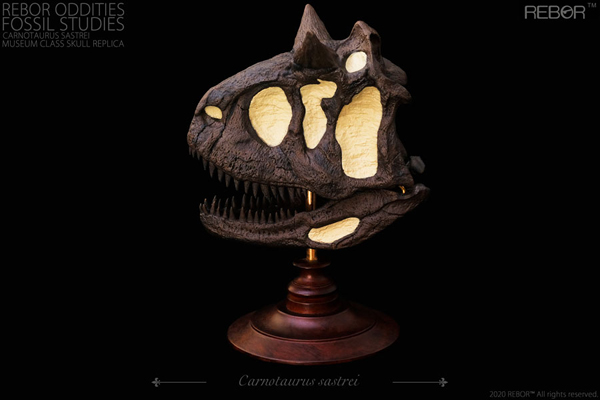A New Abelisaurid from Argentina – Koleken inakayali
A new species of South American abelisaurid dinosaur has been named by scientists. It lived in Patagonia around 69 million years ago (Maastrichtian faunal stage of the Late Cretaceous. Named Koleken inakayali it shared its estuarine environment with the much bigger, related abelisaurid Carnotaurus sastrei. Its discovery and subsequent phylogenetic analysis provides a much needed context for understanding the rate of evolution within ceratosaurian theropods. Koleken helps to reinforce the belief that abelisaurids were the most successful group of large meat-eating dinosaurs in the Late Cretaceous of Gondwana.

A life reconstruction of the newly described abelisaurid dinosaur Koleken inakayali. Picture credit: Gabriel Diaz Yantén.
Koleken inakayali
Most of the fossil material comes from a substantial concretion collected from strata associated with the La Colonia Formation of Chubut Province, southern Argentina. The concretion contained the posterior portion of the skeleton. Fragmentary pieces of skull were also recovered. Analysis of the bones suggests that the fossils represent a subadult animal, which was at least six years old when it died. Although Koleken lived at the same time as Carnotaurus, the researchers concluded that the fossils represented a new, unique abelisaurid and not a specimen of an immature Carnotaurus. Several unique characteristics of the bones were identified. Furthermore, Koleken inakayali lacked horns on its skull. Skull horns are a characteristic associated with Carnotaurus.

Carnotaurus possessed a pair of horns on the top of its head. The newly described Koleken inakayali lacked horns.
The picture (above) shows a model of a Carnotaurus sastrei skull from Rebor.
To view the range of Rebor prehistoric animal figures in stock at Everything Dinosaur: Rebor Dinosaur and Prehistoric Animal Models.
Roughened bone surface associated with the nasal area does suggest that this dinosaur may have had some sort of ridge structure running along its snout.

The fossil material was collected from deposits associated with the La Colonia Formation (Chubut Province, southern Argentina). Field team members prepare some of the fossil bones for removal. Picture credit: María Agustinho.
Coming from Clay and Water
The genus name is derived from Kóleken, a name in the local Teushen language spoken by the native population of central Patagonia that means “coming from clay and water”. The specimen was found in a sedimentary section dominated by claystone representing an estuarine environment. The trivial or species name honours Inakayal, one of the last chiefs of the native people from central Patagonia (the Tehuelches). He is known for his resistance against Argentina’s 19th century military campaign, which resulted in the decimation and displacement of native communities from southern Argentina.
Lead author of the scientific paper Diego Pol (Museo Argentino de Ciencias Naturales Bernardino Rivadavia, Buenos Aires), commented:
“The new dinosaur is represented by a partial skeleton that includes several skull bones, an almost complete set of back bones, a complete hip, several tail bones and almost complete legs”.
The carcase of Koleken inakayali was probably transported by a river to an estuary, where it was buried shortly after its death. The first fossils were discovered in 2015. Although far from complete, this specimen will help palaeontologists assess how different parts of the skeleton of abelisaurids and their close relatives changed over time.
Co-author of the paper, Fernando Novas (Museo Argentino de Ciencias Naturales Bernardino Rivadavia), explained:
“We analysed the evolutionary relationships of abelisaurids and their closest relatives, the noasaurids, and found periods of time in which these groups changed rapidly and other periods in which their evolution remained almost at a standstill.”

Fossilised bones of Koleken being cleaned and prepared for further study. Picture credit: María Agustinho.
Abelisaurids Coexisted
The discovery of this new abelisaurid expands our knowledge about Late Cretaceous theropods of South America. Koleken demonstrates that several species of abelisaurids coexisted in the same environments during the Maastrichtian faunal stage of the Cretaceous. It also shows that abelisaurids were extremely diverse compared to other types of dinosaur. Abelisaurids were probably the dominant carnivores. The larger Carnotaurus sastrei was probably the apex predator, whilst Koleken inakayali at around four to five metres in length, probably filled a secondary predator niche.
A spokesperson from Everything Dinosaur stated:
“We are learning more about ancient palaeoenvironments and the animals that existed within them. Perhaps, the African plains today can provide an analogy. You could consider Carnotaurus as fulfilling the role of a lion in this ecosystem, with Koleken filling a secondary predator niche such as a leopard.”
For Dominic
Team members from Everything Dinosaur met a remarkable young dinosaur fan called Dominic recently. Dominic knew that a new species of meat-eating dinosaur had just been announced and was keen to learn more about Koleken. We promised that we would dedicate our blog post about this new dinosaur to him. Perhaps Dominic’s mum could ask him to draw Koleken inakayali. We would very much like to see how Dominic interprets this new dinosaur discovery.
Everything Dinosaur acknowledges the assistance of a media release from the Museo Argentino de Ciencias Naturales Bernardino Rivadavia in the compilation of this article.
For Dominic.
The scientific paper: “A new abelisaurid dinosaur from the end Cretaceous of Patagonia and evolutionary rates among the Ceratosauria” by Diego Pol, Mattia Antonio Baiano, David Černý, Fernando E. Novas, Ignacio A. Cerda and Michael Pittman published in cladistics.

